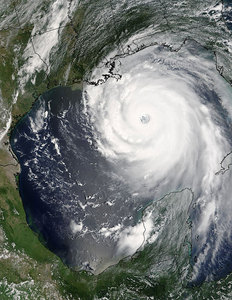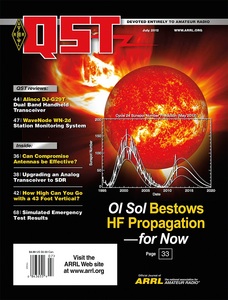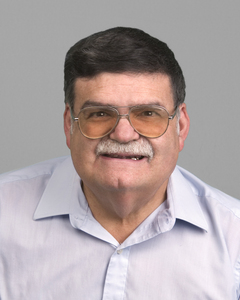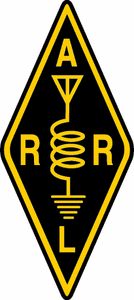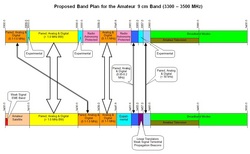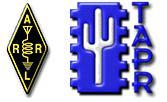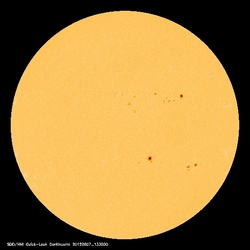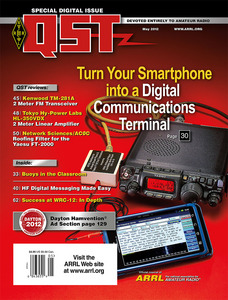 June 7, 2012 John E. Ross, KD8IDJ, Editor
| |||||||||
+ Available on ARRL Audio News. + Forecasters Calling for "Near-Normal" Hurricane Season
Forecasters with the National Hurricane Center are calling for a "near-normal" Atlantic hurricane season for 2012. In its initial outlook for the 2012 Atlantic hurricane season -- which began Friday, June 1 and runs through November 30 -- the National Weather Service's Climate Prediction Center (CPC) is calling for a 50 percent probability of a near-normal season, a 25 percent probability of an above-normal season and a 25 percent probability of a below-normal season. The 2012 hurricane season began early when Tropical Storm Alberto and Tropical Storm Beryl both developed several days before the official start of the season, the first time since 1908 that two tropical storms developed early; the only other year with two storms so early in the season was 1887. CPC forecasters say that there is a 70 percent chance of having 9-15 named storms, of which four to eight could become hurricanes, including one to three major hurricanes (Category 3, 4 or 5). These ranges do not represent the total possible ranges of activity seen in past similar years. Tropical systems acquire a name upon reaching tropical storm strength with sustained winds of at least 39 miles per hour. Tropical storms become hurricanes when winds reach 74 miles per hour and become major hurricanes when winds increase to 111 miles per hour. An average season has 12 named storms, including six hurricanes with three becoming major hurricanes. Read more here. + Check Your Mailbox for the July 2012 Issue of QST This July issue of QST features an in-depth look at Solar Cycle 24. With its slow start, many feared Solar Cycle 24 might not be as active as previous cycles. But if you've been on the air in the last few months, you know that the higher bands are exploding with activity. Propagation guru Carl Luetzelschwab, K9LA, takes a look at the current solar cycle and lets readers know what they can likely expect in the coming years. So why not set aside a couple of hours, grab a snack and get ready to explore the July issue of QST. When you think of dipole antennas, you probably envision a horizontal wire with a vertical wire hanging down from its middle. Jeff Brone, WB2JNA, couldn't put up a traditional dipole in his third-floor apartment, so played around with its configuration and came up with a new model. In his article "A Dipole Doesn't Have to Be Straight," he explains that even though some antenna is better than no antenna, just about any kind of antenna will work.
If you've ever wanted to try the new software-defined radios, but weren't too keen to give up your analog equipment, take note. Alex Schwarz, VE7DXW, has found a way to upgrade an older analog radio to an SDR at a low cost. In his article "SDR Upgrade for Analog HF Radios," learn how he created a software and hardware interface for different models of radios, produced a software package that can be used by developers to run on Windows-based platforms and used this software for the demodulation of USB, LSB and CW. The ARRL EXPO at the 2012 Dayton Hamvention was a resounding success. With tons of exhibits within the EXPO -- including the DIY Stage, the Youth Lounge and DX activities -- the thousands of Hamvention goers were never bored. ARRL News Editor S. Khrystyne Keane, K1SFA, explores the fun that is Dayton in her article "ARRL EXPO at the 2012 Dayton Hamvention." In the upcoming digital edition of the July issue, QST Technical Editor Joel Hallas, W1ZR, takes an in-depth look at the dozens of new products that vendors introduced this year at Hamvention. Look for the digital edition to be online in mid-June. More than 30 years ago, the IARU offered a no-frills 20 meter CW transceiver, dipole antenna, headphones and a Morse code key to budding hams in Asia and Africa. In 2012, one of these transceivers, sent from ARRL Headquarters, found its way back to Newington. While its journey back to the US remains a mystery, QST Editor Steve Ford, WB8IMY, tells the transceiver's story in his article "A Transceiver Comes Home." ARRL Test Engineer Bob Allison, WB1GCM, takes a look at the Alinco DJ-G29T dual-band handheld transceiver in this month's Product Review. He says the rig "covers the 1.25 and 33 cm bands - a unique combination. With this radio, amateurs can access the 33 cm band without having to convert commercial service transceivers." QST Technical Editor Joel Hallas, W1ZR, checked out the WaveNode WN-2d station monitoring system, saying that it "provides useful accuracy and a lot of flexibility in terms of what you can measure and how you can display it. I found it a useful tool and a good adjunct to my station." Of course, there are the usual columns you know and expect in the July QST: Happenings, Hints & Kinks, The Doctor Is In, Short Takes, Technical Correspondence, How's DX and more. Look for your July issue in your mailbox. QST is the official journal of the ARRL, the national association for Amateur Radio. QST is just one of the many benefits of ARRL membership. To join or renew your ARRL membership, please see the ARRL Web page. + Silent Key: Former "The World Above 50 MHz" Conductor Gene Zimmerman, W3ZZ (SK)
Gene Zimmerman, W3ZZ, of Gaithersburg, Maryland, passed away on Sunday, June 3. He was 71. Zimmerman wrote the popular QST column "The World Above 50 MHz" from 2002-2011. He also served on the ARRL Contest Advisory Committee, edited the VHF contesting column for CQ Contest magazine during its five-year lifespan and was director of the CQ VHF Contest from 2000-2002. An ARRL Life Member, Zimmerman earned VUCC on six bands: 50, 144, 222, 432, 903 and 1296 MHz, as well as DXCC, Worked All States and Worked All Continents on 6 meters. He was an early proponent of -- and participant in -- aggressive contest log checking. Read more here. ARRL in Action: What Have We Been Up to Lately?
This feature is a concise monthly update of some of the things that the ARRL is doing on behalf of its members. This installment -- which covers the month of May -- takes a look at the new digital edition of QST, the ARRL EXPO at the 2012 Dayton Hamvention, the League's response to the FCC's request concerning impediments to Amateur Radio, draft band plans for 13 and 33 cm, the results of the ARRL Video Contest, reports from the Official Observer Desk and more. Read more here. + ARRL Board of Directors Approves 9 cm Band Plan
The ARRL Board of Directors has unanimously voted to approve the 9 cm band plan, as presented by the ARRL UHF/Microwave Band Plan Committee. Earlier this year, the committee asked radio amateurs for comments on a proposed 9 cm band plan, explaining that the purpose of these band plans is to share information about how the amateur bands are being used and to suggest compatible frequency ranges for various types of applications. The committee also recognized that local conditions or needs may necessitate deviations from a band plan, and that regional frequency coordinating bodies may recommend alternatives for use in their respective regions. Read more here. + Papers Requested for ARRL/TAPR Digital Communications Conference
Amateurs are invited to submit technical papers for presentation at the 31st Annual ARRL and TAPR Digital Communications Conference (DCC), to be held September 21-23, 2012 at the Sheraton Gateway Airport Hotel in Atlanta, Georgia. These papers will also be published in the Conference Proceedings (you do not need to attend the conference to have your paper included in the Proceedings). The submission deadline is July 31. Please send papers to: Maty Weinberg, ARRL, 225 Main St, Newington, CT 06111, or you can make your submission via e-mail. For more information about the conference, see the DCC website or call 972- 671-8277. Solar Update
Tad "There's a fire starting in my heart" Cook, K7RA, reports: The average daily sunspot numbers increased about 60 percent during the past week (May 31-June 6), when compared to the previous seven days (May 24-30). The increase was 48.5 points, from 81.9 to 130.4. The average daily solar flux was also up -- 18.6 points from 111.6 to 130.2. This increase in solar activity began June 1. On May 29, the daily sunspot number was 73, with four sunspot groups visible: 1486, 1488, 1490 and 1492. On May 30, the size of groups 1486, 1488 and 1492 diminished, but 1490 grew, and the sunspot number was 78. On May 31, sunspot groups 1486 and 1488 disappeared, and new groups 1493, 1494 and 1495 appeared, but the daily sunspot number was still about the same, 76. On June 1, three new groups appeared -- 1496, 1497 and 1498 -- and the daily sunspot number jumped to 151. The next day the sunspot number was 113. On June 3, sunspot group 1499 appeared and the sunspot number was 133. On June 4, three more sunspot groups arose: 1500, 1501 and 1502. Groups 1490 and 1492disappeared, and the sunspot number jumped again, this time to 155, the high for the week and the highest since May 14 when it was 156. Geomagnetic activity peaked on June 3, when the planetary A index was 19, and the high-latitude college A index was 33. The activity continues, with the planetary A index on June 4-6 at 16, 17 and 17, and the predicted planetary A index for June 7-8 at 12 and 8, followed by 5 on June 9-17. Geomagnetic activity is expected to increase again, with a predicted planetary A index on June 18-20 at 15, 12 and 8. For June 21-25 a planetary A index of 5 is expected, followed by another peak at 15 on July 1 and again on July 15. The predicted solar flux is 140 on June 7-9, 135 on June 10-11, 130 and 125 on June 12-13, 120 on June 14-15, 115 on June 16-18, and 110 on June 19-26. The recent geomagnetic activity was caused by a coronal hole, an opening in our Sun's magnetic field, allowing solar wind to spew forth. Look for more on the ARRL website on Friday, June 8. For more information concerning radio propagation, visit the ARRL Technical Information Service Propagation page. This week's "Tad Cookism" is brought to you by Adele's Rolling in the Deep. + Martin Huyett, K0BXB, Wins May QST Cover Plaque Award
The winner of the May QST Cover Plaque award is Martin Huyett, K0BXB, for his article "An AFSK Interface for Android Smartphones." Congratulations Martin! The QST Cover Plaque award -- given to the author or authors of the best article in each issue -- is determined by a vote of ARRL members on the QST Cover Plaque Poll web page . Cast a ballot for your favorite article in the June issue today. New QuickStats Poll Now Available on ARRL Website Four new poll questions have just been published on the QuickStats page on the ARRL website. Let your voice be heard! Questions in this month's QuickStats poll:
Visit the QuickStats page and be sure to bookmark it in your browser. Results from this QuickStats poll will be published in the September 2012 issue of QST on the QuickStats page, located in the rear advertising section of the magazine. Along with monthly poll results, QST QuickStats offers colorful charts and graphs that highlight interesting Amateur Radio statistics. This Week in Radiosport This week:
Next week:
All dates, unless otherwise stated, are UTC. See the ARRL Contest Branch page, the ARRL Contest Update and the WA7BNM Contest Calendar for more information. Looking for a Special Event station? Be sure to check out the ARRL Special Event Stations web page. Upcoming ARRL Section, State and Division Conventions and Events
To find a convention or hamfest near you, click here. ARRL -- Your One-Stop Resource for Amateur Radio News and Information Join or Renew Today! ARRL membership includes QST, Amateur Radio's most popular and informative journal, delivered to your mailbox each month. Subscribe to NCJ -- the National Contest Journal. Published bi-monthly, features articles by top contesters, letters, hints, statistics, scores, NA Sprint and QSO Parties. Subscribe to QEX -- A Forum for Communications Experimenters. Published bi-monthly, features technical articles, construction projects, columns and other items of interest to radio amateurs and communications professionals. Free of charge to ARRL members: Subscribe to the ARES E-Letter (monthly public service and emergency communications news), the ARRL Contest Update (bi-weekly contest newsletter), Division and Section news alerts -- and much more! Find us on Facebook. Follow us on Twitter. ARRL offers a wide array of products to enhance your enjoyment of Amateur Radio Donate to the fund of your choice -- support programs not funded by member dues! Click here to advertise in this newsletter. | |||||||||
